It is time to return to picking the all-time lineup with my grandson Ian (who just turned 12). Coming up to bat – the catcher.
Campy and Yogi: When I first really embraced baseball, ages 10 to 15 or so, it was easy to think that the two best players in baseball were catchers Yogi Berra and Roy Campanella. In 1951, Yogi was the MVP of the American League and Campy took that award in the National League. Campy was MVP again in 1953. Yogi repeated in 1954. In 1955, they were each MVP and led their teams to the pennant (the Dodgers beat the Yankees in the 1955 Series – below, Campy batting and Yogi catching in that Series).
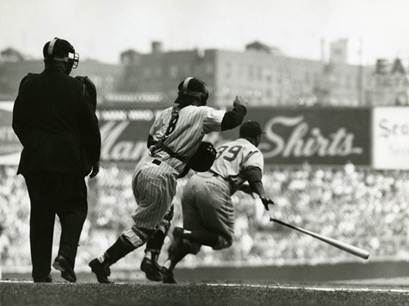
They are the only catchers to win 3 MVP awards. But their career paths were distinctly different. Yogi played 18 seasons for the Yankees, 1946 to 1963. Campy played 10 seasons for the Dodgers, 1948 to 1957. Campy began professional ball at age 15, but was initially limited to the Negro Leagues. He was 26 when he reached the majors (Yogi was 21). During the offseason between 1957 and 1958, Campy was in a car accident that left him mostly paralyzed from the shoulders down. So Campanella’s major league career was cut short at both ends, first by discrimination, and then by a horrible accident. Although his time in the majors was relatively short, it was so exceptional that the baseball writers voted him into the Hall of Fame in 1969.
If WAR is the Test: WAR (Wins above Replacement) is an all-inclusive performance number assigned to each player. It is calculated through a formula that assigns values to key statistics. Two primary sources for WAR are Baseball Reference (bWAR) and FanGraphs (fWAR). Although they use different formulas, the relative numbers are comparable. It’s not a perfect system, especially when comparing players from different eras. But it gives some perspective and is often used today in salary negotiations.
WAR is calculated for each season and career WAR is the sum of the WARs for all of a player’s seasons. The top bWAR career numbers for catcher are Johnny Bench (75.0), Gary Carter (69.9), Ivan Rodriguez (68.4), Carlton Fisk (68.3), Yogi Berra (59.5), Mike Piazza (59.4) and Bill Dickey (55.8). They are all in the Hall of Fame (counting Rodriquez who will be inducted later this month).
I have a bias for Yogi. My boyhood team was the Yankees, the parent team of our Kansas City Blues. Yogi won all those MVP trophies. The Yankees won so many World Series. And the Yogiisms. Yogi has the best WAR for a left-handed-hitting catcher. Bench has the best WAR from the right side, and so I rationalize and eliminate the other right handers: Carter, the two “Pudges,” Rodriquez and Fisk, and Piazza. Left hander Dickey is below Yogi. [Uniform Number Trivia: Bill Dickey wore #8 for the Yankees, as did Yogi; when the Yankees retired #8, it was in honor of both players.]
This narrows the choice to Johnny Bench and Yogi Berra…..and Josh Gibson (Surprise!). WAR is not always the answer. So give peace and Yogi and Josh a chance. My analysis will follow after this Peanuts break.
Charlie Brown’s Catcher: On the baseball team made famous by Charles Schulz in Peanuts, the catcher is Schroeder. He is skilled at playing classical music on his toy piano, but not so much at baseball. For example, he does not know how to throw, and he hides this by walking the ball back to the mound after each pitch. A taste of Schroeder:

Josh Gibson: Josh Gibson and Yogi Berra were both voted into the Hall of Fame in 1972. Yogi, by the baseball writers. Josh, by the Negro League Committee. You see, Josh never played in the major leagues. But he was a legend. His 17-year playing career from 1930 to 1946 drew frequent comparisons to Babe Ruth. He was often called the “Black Babe Ruth” – but there was a flip side to that comparison (see below). Maybe a Solomon solution is in order: The Babe was the best left-handed power hitter of all time and Josh was the best from the right side. Negro Leaguer Judy Johnson said that if Josh had been in the majors, Hank Aaron would have been chasing Gibson rather than Ruth.
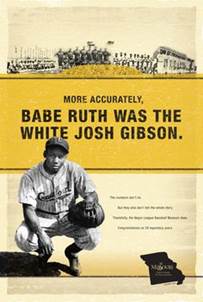
Many hoped that Gibson would be the first black in the major leagues. He had bad timing. When Jackie Robinson was signed by Branch Rickey in 1946, Gibson was 34 years old. Tragically, Gibson died after a stroke in early 1947, a few months before Jackie played his first game for the Dodgers.
In 1966, Ted Williams entered the Hall of Fame and famously gave this nudge in his induction speech: “I hope someday Satchel Paige and Josh Gibson will be voted into the Hall of Fame as symbols of the great Negro players who are not here only because they weren’t given the chance.” In 1971, Satchel Paige became the first Negro Leaguer inducted into the HOF. Two were added in 1972: Josh Gibson and Buck Leonard.
There are not sufficient reliable statistics to formulate a WAR number for Gibson. So I’ll turn instead to expert testimony:
Pitching great Walter Johnson: “There is a catcher that any big league club would like to buy for $200,000. His name is Gibson. He can do everything. He hits a ball a mile. He catches so easy he might as well be in a rocking chair. Throws like a rifle. Too bad this Gibson is a colored fellow.” Team owner Bill Veeck: “Josh Gibson was, at the minimum, two Yogi Berras.” Hall of Famer Monte Irvin: “I played with Willie Mays and against Hank Aaron. They were tremendous players but they were no Josh Gibson.” Buck O’Neil said he heard that “special” sound of a bat hitting a ball from three hitters: “Babe Ruth, Josh Gibson and Bo Jackson.” Pitcher Dizzy Dean, talking to Gibson after a barnstorming game in 1935: “Josh, I wish you and Satchel played with me ‘n’ Paul on the Cardinals. Hell, we’d win the pennant by the Fourth of July and go fishin’ the rest of the season.” [Below, Satchel and Josh at the 1942 Negro League World Series]![]()
![]()
![]()
![]()
![]()
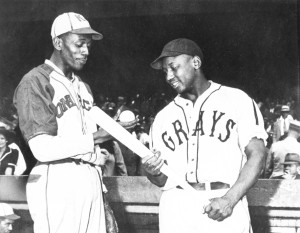
Berra and Bench – The Numbers: Yogi was a career Yankee (ignoring four player/coach games with the Mets). Bench played his entire career with the Cincinnati Reds (1967-1983). Their numbers are very similar. Yogi appeared in 2,120 games, Bench in 2,158. Games started as catcher: Berra 1,699, Bench 1,627. Bench had 389 home runs, Berra 358. Hits, Yogi 2,150, Bench 2048. Slugging Percentage, Yogi .482, Bench .476. RBI’s, Yogi 1,430, Bench 1,376.
Bench was an all-star in 14 of his 17 seasons and MVP twice. Yogi was an all-star in 15 of his 18 seasons and was a 3-time MVP.
Yogi had an edge in batting average, .285 to .267, but Bench had more walks to narrow the gap in on-base percentage (Yogi .348, Bench .342). One major difference was that Bench struck out 1,278 times and Yogi only 414. That is an amazingly low strikeout total for someone hitting over 300 home runs. Yogi’s lack of strikeouts was aided by his ability (and willingness) to swing at bad pitches and get hits.
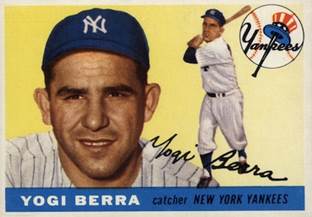
Bench has his own edge. Ten Gold Gloves. Yogi had none, but the award did not exist until later in his career. Yogi was considered to be a good (not great) defensive catcher. Bench was one of the first to use a hinged catcher’s mitt (rather than the pillow style), leaving his throwing hand free and behind his back to prevent injury. As for his arm, one pundit wrote, “It is about the size of a good healthy leg, and it works like a recoilless rifle.”
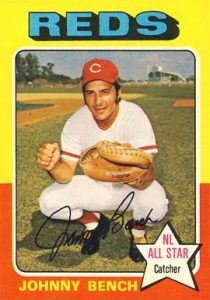
Berra and Bench – Yankees and Reds: Both Bench and Berra had the good fortune to play on some great teams. During Yogi’s 18 seasons with the Yankees, the team won 14 pennants and 10 World Series titles. Yogi is the only player in MLB history to have 10 Series rings. He has the most career hits and plate appearances in the Series, and he is third in home runs (behind Mantle and Ruth). He is part of two iconic moments from World Series history: Jackie Robinson’s steal of home in 1955 (to Yogi’s animated disagreement of the safe call) and Yogi’s leap into the arms of Don Larsen after the perfect game in 1956.
[Posnanski trivia: Joe tells this story about Yogi and Jackie’s widow Rachel Robinson. Yogi and Rachel would see each other. “Safe,” she would say. “Out,” he would say. And they would embrace.]
Bench was also part of a storied team – the Big Red Machine was the best team in the National League in the 70’s. The Reds were in the post-season six times from 1970 to 1979, winning 4 pennants and two World Series. The 1975 and 1976 teams that won the Series are considered two of the best of all time. Almost every Reds fan can still list the “Great Eight” players from the Big Red Machine: Joe Morgan, Johnny Bench, Tony Perez, Dave Concepcion, George Foster, Cesar Geronimo, Pete Rose and Ken Griffey Sr.
Best All-Time Catcher: Most “best of” lists from Sports Illustrated, ESPN, Fox, etc. select either Bench or Berra, most saying Bench. WAR says Bench. But the guru of stats, Bill James, begs to differ. In 2001, James prepared a well-publicized list of the 100 best players of all-time. This list would miss some of the more recent Hall of Fame catchers, but the order of preference among Berra, Bench…and yes, Josh Gibson, should remain the same. This is a list that starts with Babe Ruth and has three catchers in the top 50. They are Josh Gibson (9), Yogi Berra (41) and Johnny Bench (44). To put this in perspective, the top ten in the James list are Babe Ruth, Honus Wagner, Willie Mays, Oscar Charleston, Ty Cobb, Mickey Mantle, Ted Williams, Walter Johnson, Josh Gibson and Stan Musial. That’s some impressive company for Josh.
When Ian and I started this exercise, we both assumed we would end up selecting Johnny Bench. After the research to write this post, I am not as sure. And I can’t discuss it with Ian until mid-August because he is in Japan visiting his other grandparents. So I am going to hedge at the moment and save our final answer for a future post. In the meantime, I’ll be happy to hear from any Hot Stove readers who have an opinion.
Yogiisms: Any post about Yogi Berra should have at least some Yogiisms (i.e., his malapropisms). When I Googled “Yogi Berra Quotes,” I got 435,000 hits. As is the case with Mark Twain and Abraham Lincoln, Yogi gets credit for many quotes he did not make. He even has a Yogiism to make that point – the cover of his book declares “I Really Didn’t Say Everything I Said.”
Some samples: When you come to a fork in the road, take it. You can observe a lot just by watching. It ain’t over till it’s over. It’s like déjà vu all over again. No one goes there nowadays, it’s too crowded. Baseball is 90% mental and the other half is physical. Even Napoleon had his Watergate. He hits from both sides of the plate – he’s amphibious. So I’m ugly – I never saw anyone hit with his face.
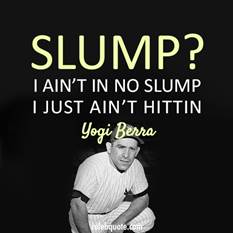
When Yogi retired, he was the all-time leader in home runs by a catcher. In 1980, Johnny Bench broke the record and Yogi sent Bench a congratulatory telegram that included one of my favorite Yogiisms : “I always thought the record would stand until it was broken.”
Active Catchers: There are at least three active catchers that will get some consideration by the Hall of Fame: Buster Posey of the Giants, Yadier Molina of the Cardinals and Joe Mauer of the Twins. Our own Salvy Perez has a good start with his five straight all-star games, but he probably needs a little more offense for a few years. In a recent KC Star article, George Brett had this quote on Salvy and the HOF: “He’s got a chance, yeah. If he’s 10 years in a row the starting catcher in the American League in the All-Star game? Holy (expletive).” Below, Salvy with Josh Gibson on the Field of Dreams at the Negro Leagues Baseball Museum.
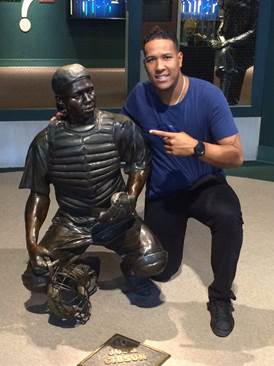
James B. Nutter Sr.: On July 7, Kansas City and the human race lost a great man, Jim Nutter. He was 89. I am not going to try and list what he did and why we will miss him. That would take several Hot Stove posts. Even his 3-column obituary could not tell it all.
If you did not personally know Jim, I am guessing you know of him from watching Royals games – the Nutter company has been a major advertiser:
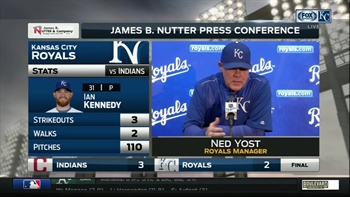
I want to share a Nutter baseball anecdote. My connection to Jim was politics, primarily during the 1970’s. We worked together on many campaigns for candidates endorsed by the Committee for County Progress. This meant long and sometimes disjointed conversations, mostly about politics, but sometimes business. He was a successful mortgage lender, but he had a gleam in his eye to own a major league baseball team. Ewing Kauffman was in his early years with the Royals, but Jim was thinking years ahead. Somehow we got around to discussing that I would be his general manager when he bought a team.
The plan was clearly flawed. Possibly related to imbibing after some political event. One part was doable – Jim could buy a team. But I had zero qualifications to be a general manager. He was humoring me, but in such a nice way. He never bought the team, but he went on to support loads of candidates and various institutions and causes for the good of the city and the planet. (Below, Rita and me with Jim last year.)
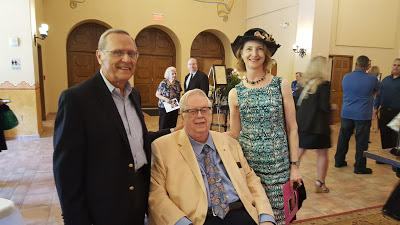
Jim had various physical ailments in recent years, but he still made it to the office almost every day. He kept an active schedule of being out and about – restaurants, Costco, etc. His work for his favorite causes continued. At Jim’s funeral, Congressman Emanuel Cleaver told a story that nicely captured Jim’s recent years:
On his eightieth birthday, John Quincy Adams was walking slowly along a Boston street. A friend asked him “How is John Quincy Adams today?” The former president replied graciously,
“Thank you, John Quincy Adams is well, sir, quite well, I thank you. But the house in which he lives at present is becoming dilapidated. It is tottering upon the foundations. Time and the seasons have nearly destroyed it. Its roof is pretty well worn out, its walls are shattered, and it trembles with every wind. The old tenement is becoming almost uninhabitable, and I think John Quincy Adams will have to move out of it soon; but he himself is quite well, sir, quite well.”
Jim Nutter was indeed “quite well” to the end. Thank you Jim. For everything.